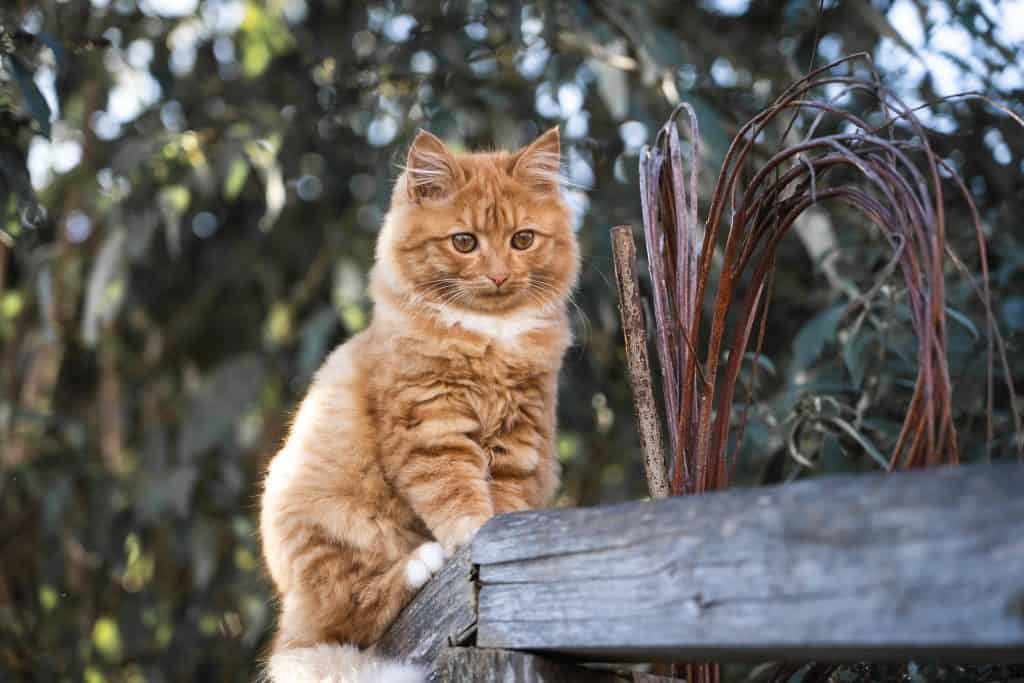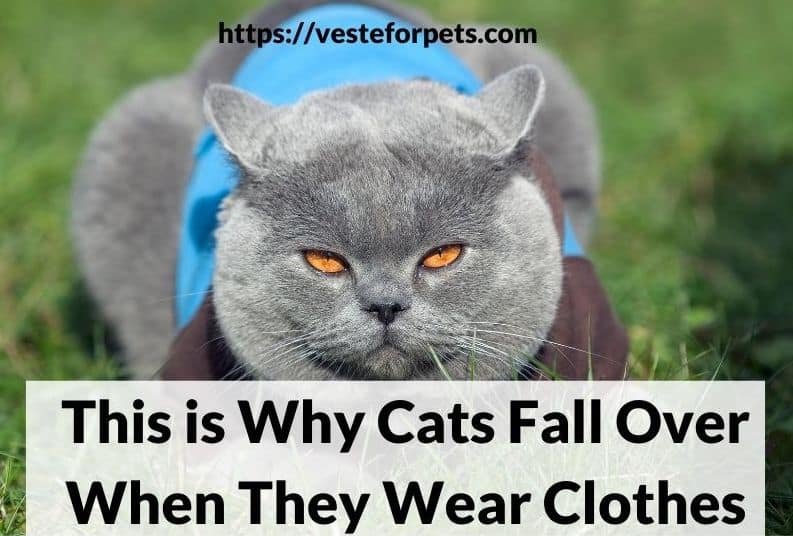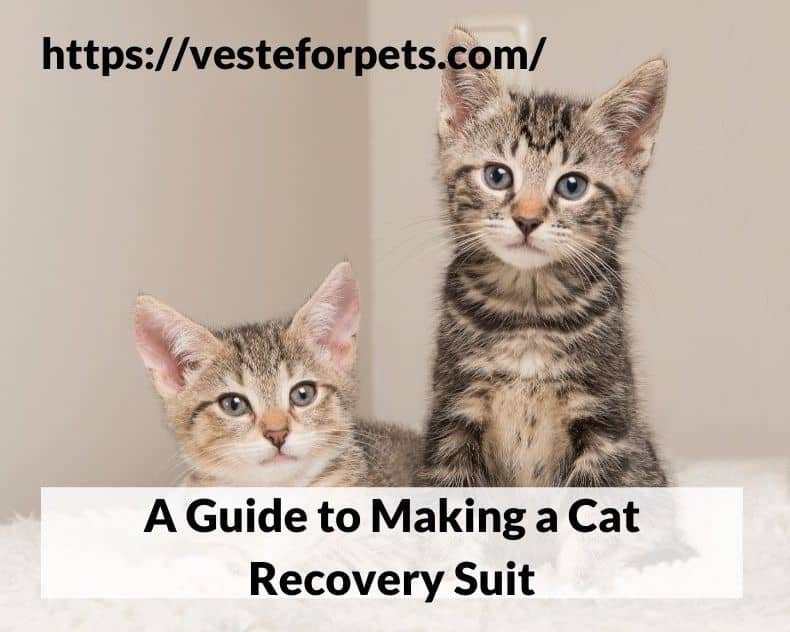Clothing on cats is an adorable and hilarious image. Often when you place clothes on a cat, they will lay down or crawl low to the ground. Other cats will become passive and just lay there until you move them. Why do cats fall over when they wear clothes?
Cats falling over when wearing clothes is a sign of passivity or a by-product of the fight for flight mechanism. Kittens are used to being carried by their mothers by the scruff of their necks. Clothing simulates the grabbing of the scruff and forces the cat into a passive state.
Cats are unique and rambunctious creatures that can be welcome friends and constant companions. Using clothes to take pictures or even leash train the animal is a prevalent thing, but there are hours of training involved that could be overwhelming. Don’t let it get you down! Read on and learn why cats fall when you put clothes on them.
Why Cats Fall Over When Wearing Clothes
Clothing for cats has come into fashion recently, and the social media world has been flooded with adorable cats in hats and coats. What you don’t see before these snaps are taken is the cat’s reaction to being placed in the clothes. Often cats will goose-step around the room if placed in boots and go limp when adorned in coats and shirts.
Kittens rely on their parents to protect them as they grow. At their earliest stages, they are carried by the scruff of the neck to escape the elements or an unsafe situation. They learn at this young age that once pressure is applied to that area of the neck, to go limp. Being passive allows them to remain unharmed while they are moving.
Passivity is Common in Domesticated Animals
Studies show that once animals become accustomed to their surroundings and humans, they will indicate this passive state by rolling over. When a cat rolls onto its back and extends its front paws playfully, they are showing submission to you. Placing a jacket on a cat triggers this same response.
While the response that cats show to clothing is predictable, you can also train them. There are leashes and apparel that will take time and practice, but your cat will learn to use them. Working with a leash is an excellent entryway into wearing clothing, and if the cat is on the skittish side, a leash might be the only thing you can get them to wear.
Reasons Why Cats Become Passive When Wearing Clothes

Like most other animals, the nervous system is going to control a massive amount of its reactions and bodily functions. Just like people, cats will have different responses to all kinds of situations. Be prepared to hold your cat and console them during the process to acquire a permanent aversion to wearing clothes.
Fear is the Number One Reason Cats Avoid Clothing
The flight or flight reflex is the main reason that cats go limp when wearing clothes. They will lock up and fall over like a tree in a tornado. The clothes’ extra weight will make them think they are being carried or attacked, and they will submit. The cat’s mind will lockdown, and the body will follow close behind.
The best way to keep your cat calm is to hold them close and pet them. As you are petting, you can inch over the garment and see what happens. In a controlled environment, the cat will allow you to do much more than if you snatch them up and attempt to put something on them. Be gentle, and you will get much farther than going with the power approach.
If you know your cat’s personality, you can prepare for the times when you will put clothes on them. Once they get used to the routine, they could break the fear cycle and function normally with any clothing you could slap on them.
The Clothing Could Have Weird Smells or Sounds
Cats have some senses that make humans look simple in comparison. They can smell things that humans can’t and have hearing that allows them to pick up prey in low-lighted areas. If you drape them in a smell they don’t recognize or scare them; they are sure to fall over. Choose things that have a neutral smell and won’t send them running away.
While you might not be able to smell things in the clothing, cats absolutely can. If they revolt against a particular item, make sure that it is clean and isn’t washed in something that will trigger them. Better yet, choose a smell they are familiar with and mix it with the clothing. This will familiarize them with the clothing and increase the chances of not going limp.
The senses of a cat are powerful and could make the cat act hilariously. Any type of clothing that obstructs the nose or ears could force them to wiggle it off their head. As cool as a hat on a cat sounds, you should think about how it is going to impact the cat before you sink cash into an expensive cat hat.
Clothing Shouldn’t Block Cat’s Body Language.
Cats can be vocal. They let out yowls and cries that people and other felines recognize but also communicate with body language. One of the best examples is the classic Halloween decoration with a cat with its hackles raised. When a cat does this, they are scared or amid a conflict.
The clothing you choose for the cat will hamper their ability to use body language to get their point across. This could lead them to shut down or take a rest right where they are. Being unable to communicate will keep them passive and mean that no matter what kind of cool threads they have on, they won’t like them or move around much.
Make Sure the Cat’s Clothing is the Appropriate Size
Small clothes are uncomfortable. Cats feel the same way about them as you do. They want to wear things that don’t restrict movement. Movement restriction is at the top of the list for something that will make a cat go passive. Choose clothes that don’t limit limb restriction and keep the cat able to move as freely as they want.
Clothing choices for cats are unlimited. Whatever you decide to dress them in, choose something that won’t force them to bolt as soon as they see it. Most cat owners’ favourite is a good poncho that will keep them dry and warm if they are in a different climate than they are familiar with.
Something that is overlooked when dressing cats is how the garment will fit the cat. If you have the clothing custom-made, be sure that you send the appropriate measurements when ordering. If there’s a problem with the fit, a cat could just lay there and never attempt to learn to move while wearing the outfit.
How the Cat Sees Should Not be Impacted by Their Clothing
Like the feet and whiskers, a cat’s eyes are essential to how they function and survive. If there are hats and scarves involved in the dressing, you should choose something that keeps their line of sight free from obstruction. As soon as their sight goes, they will flop and stay down as long as they can’t see.
Hats and goggles can be one of the most used items when dressing cats. A tiny hat on their head is cute and will get people smashing the like button to show you just how much they think about it. Choose something that keeps them from being overwhelmed and losing their sight. They will freak out when the sight goes and could be immovable for a long time.
Eyes for a cat are the balance that makes all the other senses work. They can see well in low light and use vision to judge gaps when leaping. Anything that keeps them from having a full field of view could be dangerous for them.
Is it Bad to Put Clothes on Cats?
It isn’t bad to put clothes on a cat. In the long run, a cat wearing clothes becomes second nature to them. The thing to keep in mind is to concentrate on things that don’t overly restrict movement. This closed-off feeling could trigger the passive response that you are trying to protect against.
Training Your Cat to Wear Clothes
Cats are notorious for not doing things that they don’t want to. Training a cat to wear clothes could override some of its most basic instincts. There will be times that the animal will fly into full retreat to get away from the clothing. Ease them into the process if they are extremely skittish.
Begin with Small Pieces of Clothing and Work Upwards
Clothing that restricts a cat’s movement at either hip should be avoided when starting. If you are going to put them in a coat, it will trigger a response that could take some getting used to. Start with something that is light and only covers the upper portion of the legs and back. Less restrictive garments are going to be the best way to go.
Some ideas for small clothing for cats are:
- Vests – A vest on a cat is adorable. It is also a great place to start when training them to wear clothing. It allows enough room for the cat to move its back and upper limbs while covering the areas that can trigger the passive response. A light material, like cotton, will allow them to stretch and won’t add lots of weight to their back.
- Coat – Coats with longer sleeves could work for cats who aren’t afraid or go completely limp. Restricting the elbows and arms is always a tricky situation when dealing with cats. They could be too frightened to move if their joints won’t work correctly. Use slits in the sleeves to help them move if they need it.
- Poncho – Just like people, cats enjoy the freedom of movement in a poncho. A poncho works well because there is no restriction of the action in the limbs, and the fabric is usually light.
Shoes and Boots are Going to Take Time and Practice
One of the funniest internet videos is of cats trying on boots or socks for the first time. The cats will lose their sense of feel for the ground and walk around awkwardly. The pads on the bottom of their feet are sensitive and provide them with needed information. When this connection is severed, they become unsure and will do some crazy-looking things to compensate.
Be prepared to spend several hours training cats to wear shoes or boots. Their feet are responsible for their dexterous landings, and claws allow them to scale small walls and trees. Taking this away from them will take some getting used to, and they could even rebel against footwear altogether.
Bodysuits are a Staple When Training for Wearing Clothes
Most of the cat fashion that you see on the internet only concentrates on the top half of the cat. The fancy coats and blouses are designed for photoshoots and internet fandom. Most functional cat clothing is like clothing you would put on a young baby—a single garment with room for the head and legs to protrude.
The bodysuit works best for training cats because it hugs close to their body while not impacting any of the limbs. The fabrics are usually made from a lighter material and will be form-fitting to cover any wounds or surgical incisions. While not fashionable, the bodysuit works best for cats as it becomes part of them instead of flowing garments made for people.
Often a bodysuit will be used as an undergarment before more clothing is added to the mix. Having them accustomed to a bodysuit will ensure that stacking more clothing on top can be achieved.
Use Short Focused Training Sessions
When it comes to training sessions, you should focus on the specific piece of clothing you are working on. Keeping the sessions focused allows the cat to make solid progression instead of fighting against futility. Train specifically, and the cat will be wearing a top hat and coattails before the month is out.
Use the short sessions regularly to have the best results. The systems being overridden in the cat’s brain and nervous system are powerful, and keeping a regular schedule will be your most trusted ally in the battle for cats’ clothes. Set a time and stick with it. Cats, like humans, are creatures of habit. Keep them moving to make the training work.
Being a taskmaster and forcing the cat through the exercises is your job as the pet’s owner. Don’t look at the sessions as punishment but as a way to provide your cat with tools that it needs to wear clothing. For hairless felines, learning to wear clothing could mean the difference between life and death.
Types of Clothing for Cats
When it comes to clothing for cats, you would be surprised how many companies make a living off cat clothing. There are various colours and even sets of eveningwear that feature some of the most respected names in fashion. What it all boils down to is what the purpose for wearing the garments is.
The three main types of clothing for cats are:
- Functional – Functional cat clothing is made for cats to recover from surgery or protect them from the elements. Hairless felines that visit colder climates will need to have a coat that keeps them warm. Coats and Parkas for cats are some of the most common functional clothes that cats could wear.
- Fashionable – Fashionable cat clothing will make you rethink everything in your closet. Some of the most influential and sought-after designers have begun to create fashion for cats that not only makes them extra lovable but ready for the red carpet as well. Dolce and Gabbana make a cape for cats that rivals any cape you could buy for yourself.
- Fun – Cat clothes, above all else, are made to have fun. The last category of clothing takes all that is kitsch and brings the ‘Awww’ factor. Fun cat clothes will have neat slogans or ironic pictures on them. T-shirts with excellent graphics are a big hit with cats and should be bought regularly to keep them used to wearing them.
There are some significant players in the cat clothing market. They pump out products that can put a dent in your wallet and put the fear of God in your cat. Cat clothes that don’t serve a purpose are out there, and you can expect to spend a great deal of cash finding the right outfit for your fantastic feline.
Conclusion
Cats falling over when clothes are placed on them is a fight or flight response that makes them passive. It triggers because their senses become overwhelmed with the weight or even smell of the clothing. They lean on their instincts from an early age to go passive as their parents move them.
Cats can be trained to wear clothes just as they can be taught to walk on a leash. You should start with light clothing that doesn’t restrict movement and work your way towards heavy garments. Choose clothes that allow them to still be cats while making them clickbait for all your friends and family.
Content Disclaimer
The information contained above is provided for information purposes only. The contents of this Blog article are not intended to amount to advice, and you should not rely on any of the contents of this Blog article. Professional advice should be obtained before taking or refraining from taking any action as a result of the contents of this Blog article. VesteForPets.com disclaims all liability and responsibility arising from any reliance placed on any of the contents of this Blog article.
Copyright Notice
These works are protected by copyright laws and treaties around the world. We grant to you a worldwide, non-exclusive, royalty-free, revocable licence to view these works, to copy and store these works and to print pages of these works for your own personal and non-commercial use. You may not reproduce in any format any part of the works without our prior written consent.
Copyright © 2022 – 2024 Veste For Pets







